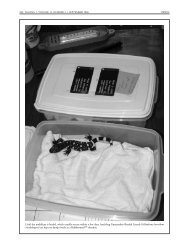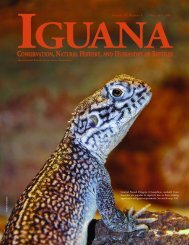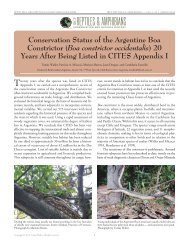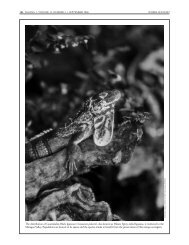Spiny-tailed Iguanas (Ctenosaura similis) in Venezuela
Spiny-tailed Iguanas (Ctenosaura similis) in Venezuela
Spiny-tailed Iguanas (Ctenosaura similis) in Venezuela
Create successful ePaper yourself
Turn your PDF publications into a flip-book with our unique Google optimized e-Paper software.
GAD PERRY<br />
HISTORICAL PERSPECTIVES<br />
of sight. Whether they are dead, or only sleep<strong>in</strong>g, we do not<br />
know. They lived, however, some seven or eight weeks, were<br />
active, seemed well and happy and, as far as we know, never ate<br />
a mouthful of anyth<strong>in</strong>g dur<strong>in</strong>g the entire time. I neglected to<br />
mention that the old snake shed her sk<strong>in</strong> once dur<strong>in</strong>g her cap-<br />
IGUANA • VOLUME 15, NUMBER 3 • SEPTEMBER 2008 171<br />
Editor’s comments: Three Snake Stories<br />
Those of us liv<strong>in</strong>g <strong>in</strong> the age of the Internet often forget how fast and far science has come. The journal Science is published<br />
by the American Association for the Advancement of Science and was established <strong>in</strong> 1848. The journal has come out weekly<br />
s<strong>in</strong>ce 1880, leav<strong>in</strong>g a record of what was considered noteworthy for the past 130 years. Among other topics, the current<br />
issue (Vol. 320, No. 5877) discussed climate change, quantum dots, nanotubes, and DNA extracted from fossilized feces<br />
left by pre-Clovis humans — none of which would have made sense to the orig<strong>in</strong>al authors and readers of the journal.<br />
Organismal biology has been featured <strong>in</strong> Science throughout its existence. Here we feature three short pieces that discussed<br />
snake biology. The oldest and shortest, from 1892, described a snake found <strong>in</strong> the stomach of another snake. The<br />
descriptions of the animals are so vague that we have been unable to determ<strong>in</strong>e what species are described. We know a lot<br />
more about snake diets today, yet notes such as this still appear and convey new <strong>in</strong>formation. For example, a report due to<br />
be published soon <strong>in</strong> Herpetological Review describes, for the first time, cannibalism <strong>in</strong> Alsophis portoricensis. Although the<br />
lack of specific <strong>in</strong>formation would make the Kempton piece unacceptable <strong>in</strong> any journal today, we still need good natural<br />
history observations.<br />
The second piece, published a year later, also is anecdotal: the author’s son got a snake, which gave birth. The author,<br />
clearly a layperson, was astounded by how long it took the poor animals to die <strong>in</strong> the absence of food, and how lack<strong>in</strong>g <strong>in</strong><br />
maternal <strong>in</strong>st<strong>in</strong>cts the mother was <strong>in</strong> the face of cont<strong>in</strong>ued harassment of her offspr<strong>in</strong>g. Today, none of this would be news.<br />
At the time, it was deemed worthy of publication.<br />
The f<strong>in</strong>al piece, now just over 100 years old, is the only one penned by a scientist, albeit a geologist. Cl<strong>in</strong>ton Hart<br />
Merriam, named <strong>in</strong> the article, was one of the giants of natural history dur<strong>in</strong>g his lifetime (1855–1942). Although his focus<br />
was on birds and mammals, his many contributions are still recognized <strong>in</strong> scientific names such as the Canyon Lizard<br />
(Sceloporus merriami), found <strong>in</strong> Texas and Mexico. The other professional mentioned, Leonhard Hess Stejneger, was Curator<br />
of Herpetology and later the Head Curator for Biology at the Smithsonian. In the late 1800s, another herpetological giant,<br />
Edward Dr<strong>in</strong>ker Cope, described <strong>in</strong> his honor Zamenis stejnegerianus (now <strong>in</strong>cluded <strong>in</strong> Coluber constrictor, the Black Racer)<br />
and Eleutherodactylus stejnegerianus, Stejneger’s Ra<strong>in</strong> Frog, a name still recognized today.<br />
Gad Perry<br />
Apparent cannibalism <strong>in</strong> Puerto Rican Racers (Alsophis portoricensis). This snake (top) died <strong>in</strong> an effort to cannibalize another <strong>in</strong>dividual and this<br />
apparent effort to kill and consume another snake ended with humans “rescu<strong>in</strong>g” the <strong>in</strong>tended victim (bottom).<br />
tivity, unfortunately, it was dur<strong>in</strong>g our absence, and we did not<br />
witness the operation.<br />
It certa<strong>in</strong>ly seems strange that, with so much fast<strong>in</strong>g, they<br />
none of them should look th<strong>in</strong> and poor, but should apparently<br />
grow and <strong>in</strong>crease when hav<strong>in</strong>g consumed noth<strong>in</strong>g.<br />
APRIL BATES








